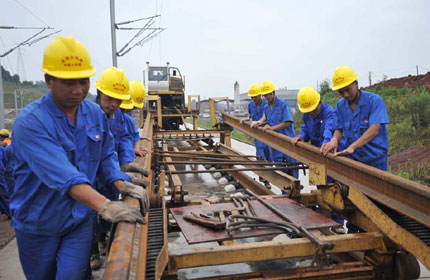Myanmar pagoda replica given to China
Updated: 2014-07-01 07:38
By Hou Liqiang and Qi Xin in Luoyang, Henan (China Daily)
|
|||||||||||
Myanmar's government handed over to China a Myanmar-style shrine, built in Henan province, that officials and experts said will greatly enhance bilateral relations.
President U Thein Sein, on behalf of Myanmar, gave textual materials for the shrine to Master Yinle, the abbot of White Horse Temple in Luoyang, in a religious ceremony that lasted more than two hours.
The ceremony was conducted by dozens of Buddhists from the two countries.
The shrine is a one-third-scale replica of the Shwedagon Pagoda, a 2,600-year-old icon of Buddhism located in Myanmar's capital, Yangon.
The smaller shrine in Henan is 32.92 meters tall, with a tower foundation diameter of 51.71 meters. It is the main structure of a temple complex that covers 7,020 square meters. The official foundation-laying of the temple was conducted in April 2012, and the main work was completed in June 2013.
All the building materials were donated by the Myanmar government.
"The Shwedagon Pagoda has an important position in the mind of the people of Myanmar. We are very happy to see a replica built here," said Aye Ko Ko, deputy director of the East Asia and Pacific Division of the Political Department at the Ministry of Foreign Affairs of Myanmar, who attended the ceremony.
Others hailed the move as well. "The event is significant for both countries," said Su Xiuyu, a professor of the Myanmar language at Beijing Foreign Studies University.
"Myanmar is very respectful of Buddhism. The White Horse Temple is the place where Buddhism was first introduced to China. The building of a replica of Shwedagon Pagoda will strengthen the friendship of the two countries."
Before the temple was built, there were Indian-style and Thai-style shrines at the White Horse complex.
The completion of the new shrine is the result of the joint efforts of Myanmar and China, U Thein Sein, Myanmar's president, said during the ceremony. He characterized it as a milestone symbolizing amity between the people of both countries and something that signals lasting friendship.
The shrine also stands as a symbol of Buddhist exchanges that will bring happiness and luck to both countries, said Wang Zuoan, director of the State Administration for Religious Affairs.
Contact the writers at houliqiang@chinadaily.com.cn and qixin@chinadaily.com.cn
Zhang Leilong in Luoyangcontributed to this story.
(China Daily 07/01/2014 page3)
Today's Top News
Palace Museum feeling the squeeze of visitors
Myanmar pagoda replica given to China
US sends 300 more troops to Iraq over concerns
Hong Kong at the crossroads
Japan pushes for military reform
China's move to domestic software pressures foreign companies
Chinese firm sues Apple for trademark infringement
Emperor penguins waddling to extinction, study finds
Hot Topics
Lunar probe , China growth forecasts, Emission rules get tougher, China seen through 'colored lens', International board,
Editor's Picks

|

|

|

|

|

|





